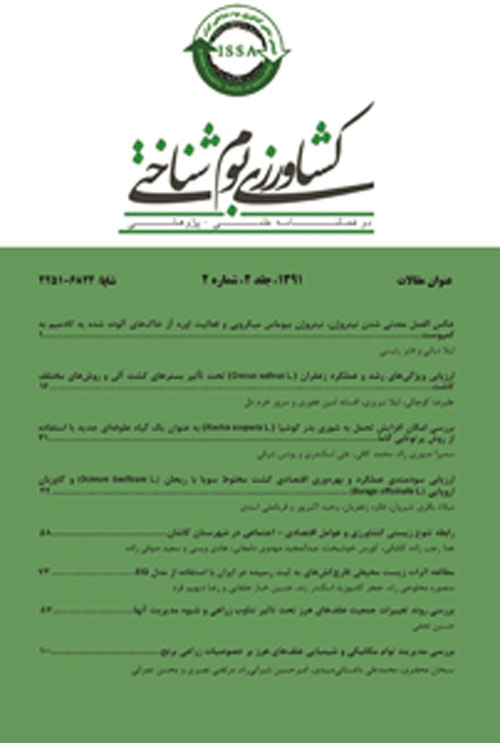Effect of nitrogen nanofertilizers and urea on yield and nitrogen efficiency in potatoes
Author(s):
Abstract:
Introduction
Nitrogen is needed in plants to form chlorophyll as well as to increase crop protein and plant yield. Application of too much nitrogen-containing fertilizers, however, is not economical. It has the additional disadvantage that it ultimately ends up in groundwater resources. Potato production in light soils usually requires a high consumption of nitrogen and frequent irrigation. At the beginning of the growing season, potatoes need a lot of nitrogen. High consumption of it at the end of the growing season, however, will cause increased foliage instead of larger tubers. Studies with high levels of nitrogen input aimed at comparing fertilizer regimes have also shown differences in nitrogen use efficiency (NUE). In recent years, the use of nanotechnology has been considered. With respect to the food recommended in most cultures, and limited research on the efficacy of nanofertilizers on crops, the present study is meant to evaluate the effectiveness of two types of nitrogen nanofertilizers, sulfur-coated urea and urea fertilizer, on potato crops.Materials And Methods
The effect of nitrogen fertilizers on nitrogen efficiency in potato cultivation were investigated by performing a factorial experiment based on a completely randomized design with four fertilizer treatments. These included applications of Nano-Nitrogen Chelate (NNC), Sulphur Coated Nano-Nitrogen Chelate (SNNC), Sulphur Coated Urea (SCU) and Urea (U) in the greenhouse over two years. Each treatment, including 46 kg-N/ha, 92 kg-N/ha, and 138 kg-N/ha, with three replications were compared. The study parameters included nitrogen efficiency indices, leaf nitrogen percentage, yield and tuber nitrate. Also calculated for each treatment were the N-efficiency parameters of Agronomic-Nitrogen Use Efficiency (A-NUE), Economic-Nitrogen Use Efficiency (E-NUE), Nitrogen Uptake Percentage (NUP), Agronomic-Physiologic Nitrogen Use Efficiency (A-PNUE) and Economic-Physiologic Nitrogen Use Efficiency (E-PNUE)Results And Discussion
The results showed that the maximum nitrate concentration of 240 mg kg-1 in tubers was obtained using 138 kg-N ha-1 supplied from urea. The lowest nitrate concentrations came from the nanofertilizer and SCU treatments. In total fertilizer treatments with increased N application, the amount of A-NUE, E-NUE and NUP decreased in both years. The SNNC in the first year and SCU in the second year had the highest E-NUE and ANE of the fertilizer sources. Comparison of means indicated that the highest tuber nitrate in the first year (215.63 mg kg-1) and in the second year (239.7 mg kg-1) was the outcome of the 138 kg-N ha-1 U treatment. Also, the results showed that in the first year, the highest E-NUE was the product of the first nitrogen level of SCU while the lowest levels were produced by the third nitrogen level of urea. It may therefore be concluded that nanofertilizers and SCU are more efficient in cultivations with nitrogen requirements. The changes in the E-PNUE index are similar to those in the E-NUE index. In other words, the values of E-PNUE and E-NUE decrease with increasing fertilizer applications while that of the E-PNUE increases with increasing nitrogen. The potato experiments of Darwish et al. (2006) and Halitligil etal. (2002), showed that E-NUE and E-PNUE were reduced with increasing nitrogen levels of urea treatment. The A-NUE and A-PNUE did not affect yield equally. Also, the role of fertilizers with equal nitrogen in yield increase did not have the same function; nanotechnologies have a synergistic effect on plant response to nitrogen use.Conclusion
Since a higher yield with the least adverse environmental effects is paramount in the third millennium, it is essential to use suitable fertilizers. The application of nanotechnology to agriculture in recent years has attracted much attention. In this study, reduced nitrate leaching and increased potato yield with an emphasis on reduced soil and water pollution were investigated in experiments with treatments that consisted of three nitrogen levels of NNC, SNNC, SCU, and U. The results showed that the 138kg-N/ha SNNC and 138kg-N/ha NNC produced the highest tuber yield. The lowest yield was obtained from the application of 138kg-N/ha U fertilizer. Comparing N-efficiency parameters showed that the highest E-NUE value was obtained with the first nitrogen level of SCU and lowest was the outcome of the third nitrogen level of Urea. Moreover, comparison of different levels of nitrogen indicated that low nitrogen levels in slow-release fertilizers performed better than the high levels of U fertilizer, which indicates an economic advantage as well. Since this experiment was conducted under greenhouse conditions, repeating this research in field conditions and with other crops is recommended.Keywords:
Language:
Persian
Published:
Journal of Agroecology, Volume:7 Issue: 1, 2017
Page:
81
magiran.com/p1733918
دانلود و مطالعه متن این مقاله با یکی از روشهای زیر امکان پذیر است:
اشتراک شخصی
با عضویت و پرداخت آنلاین حق اشتراک یکساله به مبلغ 1,390,000ريال میتوانید 70 عنوان مطلب دانلود کنید!
اشتراک سازمانی
به کتابخانه دانشگاه یا محل کار خود پیشنهاد کنید تا اشتراک سازمانی این پایگاه را برای دسترسی نامحدود همه کاربران به متن مطالب تهیه نمایند!
توجه!
- حق عضویت دریافتی صرف حمایت از نشریات عضو و نگهداری، تکمیل و توسعه مگیران میشود.
- پرداخت حق اشتراک و دانلود مقالات اجازه بازنشر آن در سایر رسانههای چاپی و دیجیتال را به کاربر نمیدهد.
In order to view content subscription is required
Personal subscription
Subscribe magiran.com for 70 € euros via PayPal and download 70 articles during a year.
Organization subscription
Please contact us to subscribe your university or library for unlimited access!


